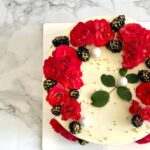Are you looking to elevate your cake decorating skills and create stunning, floral-inspired designs? In this article, we will explore the art of cake decorating and specifically focus on the beauty of using roses as a decorative element. Whether you’re a beginner or experienced baker, learning how to make roses for cake decorating can add an elegant and romantic touch to any celebration.
The process of creating intricate and lifelike rose decorations requires specific tools and materials. From piping bags and tips to various colors of buttercream or fondant, we will detail everything you need to bring your floral cake designs to life. With the right guidance and techniques, you’ll be able to achieve professional-looking results that will impress your friends and family.
In the following sections, we will provide step-by-step instructions for preparing the cake, making the perfect buttercream for piping roses, exploring different piping techniques, coloring and shaping the roses, arranging them on the cake effectively, and adding finishing touches. By the end of this article, you’ll have all the knowledge and inspiration needed to create a beautiful rose-decorated cake that will be a memorable centerpiece for any special occasion.
Tools and Materials Needed
When it comes to creating beautiful and realistic rose cake decorations, having the right tools and materials is essential. Here, we’ll detail the specific items you’ll need to make stunning rose cake decorations that will impress your friends and family.
Piping Bags and Tips
One of the most important tools for creating rose cake decorations is a set of piping bags and tips. Look for small round tips specifically designed for piping roses, such as Wilton’s #104 or #127 tips. These tips are perfect for creating lifelike rose petals with ease. Additionally, having multiple piping bags on hand will allow you to easily switch between different colors of buttercream as you create your roses.
Buttercream or Fondant
In order to create colorful and realistic roses, you’ll need a variety of buttercream or fondant in different shades. For buttercream, gel food coloring can be added to achieve vibrant and diverse colors – from deep reds to soft pinks. When working with fondant, consider purchasing pre-colored fondant or adding gel food coloring to plain white fondant for custom shades. Having a range of colors at your disposal will help you create beautifully nuanced and realistic-looking roses.
Flower Nail
A flower nail is an essential tool for creating individual rose petals before transferring them onto the cake. This small, flat-topped metal tool allows you to pipe individual petals directly onto it, which can then be placed in the refrigerator to firm up before adding them to the final cake design.
By ensuring that you have all of these tools and materials on hand, you’ll be well-equipped to dive into the art of creating stunning rose cake decorations that will elevate any special occasion dessert. Combined with the right techniques and creativity, these foundational components will enable you to craft beautiful floral designs that captivate anyone who sees them.
Preparing the Cake
When preparing a cake for decorating with beautiful buttercream roses, it is essential to start with a well-baked and perfectly level cake. Begin by preheating your oven to the specified temperature in your chosen recipe. Grease and flour the cake pans to ensure easy removal of the baked cakes. Once baked, allow the cakes to cool completely before attempting to decorate them.
Leveling the Cakes
Before stacking and decorating the cakes, it’s important to level them. This can be done using a long serrated knife or a cake leveler. Carefully slice off any uneven or domed portions of the cakes to create a flat, even surface for decorating.
Crumb-Coating the Cake
After leveling the cakes, it’s time to apply a crumb coat. This thin layer of frosting seals in any loose crumbs from the cake, providing a smooth base for additional decorations. To apply the crumb coat, spread a thin layer of frosting over the entire surface of each cake layer. Then, place the coated layers in the refrigerator for at least 30 minutes to allow the crumb coat to set before proceeding with additional decorations.
Once your cake has been leveled and crumb-coated, it is ready for creating stunning buttercream roses and other decorative elements that will elevate its appearance from ordinary to extraordinary. With these simple yet crucial steps in mind, you are well on your way toward mastering how to make roses cake decorating that will impress and delight anyone who sees – and tastes – your creation.
Making the Buttercream
When it comes to cake decorating, the buttercream used for piping roses plays a crucial role in achieving beautiful and realistic floral designs. To begin, gather the necessary ingredients for your buttercream, including unsalted butter, powdered sugar, vanilla extract, and heavy cream. It is important to ensure that your butter is at room temperature to achieve the right consistency for piping.
To make the perfect buttercream for piping roses, start by beating the softened butter in a mixing bowl until it becomes light and fluffy. Gradually add in the powdered sugar, ensuring that it is fully incorporated before adding more. This will create a smooth and creamy base for your buttercream. Next, add in the vanilla extract for flavoring and a small amount of heavy cream to achieve the desired consistency.
Achieving the right color for your buttercream is also essential when creating realistic rose decorations. Whether you choose to use gel food coloring or natural dyes, it’s important to gradually add small amounts of color to your buttercream until you achieve the desired shade.
Remember that you can always add more color, but you cannot take it away, so start with a small amount and adjust as needed. By following these steps and tips, you can create the perfect buttercream for piping roses to adorn your beautifully decorated cake.
Piping Techniques
Creating realistic and beautiful roses on a cake involves mastering different piping techniques. Whether you’re a beginner or an experienced baker, perfecting these techniques can take your cake decorating skills to the next level. This section will provide detailed instructions on how to create spiral roses, ruffle roses, and rosettes using buttercream or fondant.
Spiral roses are a classic and timeless choice for cake decorating. To make spiral roses, start from the center of the flower nail or the desired location on the cake. Hold your piping bag at a 90-degree angle and pipe a small cone shape as the center of the rose.
Next, continue piping in a circular motion around this cone, gradually moving outward to create layers of petals. The key is to maintain consistent pressure on the piping bag and move smoothly in order to achieve uniform and elegant spiral roses.
Ruffle roses, also known as frill or frilly roses, offer a delicate and romantic touch to any cake design. To create ruffle roses, hold your piping bag at a 45-degree angle with the narrow end of the petal tip touching the surface of the cake.
Apply steady pressure while moving the tip back and forth in small motions to create ruffled petal edges. Continue layering these ruffles around each other to form a full and textured rose that adds dimension and charm to your cake.
Rosettes are another popular choice for cake decorators, offering versatility in style and design. Create rosettes by holding your piping bag at a 90-degree angle with your chosen petal tip in contact with the cake. Pipe a small dot as the starting point for each rosette, then continue piping petals in circular motions around this center point to build up beautiful clusters of flowers across your cake.
Mastering these piping techniques will allow you to create stunning floral designs that elevate your cakes from ordinary to extraordinary. With practice and patience, you can use these techniques to craft intricately detailed rose decorations that are sure to impress anyone who sees them.
| Rose Piping Technique | Description |
|---|---|
| Spiral Roses | A classic choice involving layers of petals created in a circular motion |
| Ruffle Roses | Delicate option with textured edges achieved through back-and-forth motions |
| Rosettes | Versatile choice allowing for clusters of flowers created in circular motions |
Coloring and Shaping the Roses
Creating lifelike rose decorations for a cake involves careful attention to detail and a skilled hand. One of the key elements in achieving realistic-looking roses is using the right colors and properly shaping and layering the petals. Here’s a detailed guide on how to color and shape buttercream for beautiful rose cake decorations.
When it comes to coloring the buttercream for your roses, it’s essential to use gel or paste food coloring rather than liquid food coloring. Gel or paste colors are concentrated and will not alter the consistency of your buttercream, which is crucial for piping intricate flower designs.
Start with a small amount of color and gradually add more until you achieve the desired shade. Keep in mind that you can mix different colors to create custom shades for your roses.
As for shaping and layering the petals, begin by preparing a piping bag fitted with a petal tip (such as Wilton tip #104). You’ll want to pipe an opening center onto your flower nail, then continue piping petals around it in concentric circles. To make open blooms like garden roses, pipe larger outer petals with slightly darker tinted buttercream compared to buds or inner layers.
Follow these steps carefully, pausing between each movement to ensure that your petals are well-defined as you rotate your flower nail. The result will be beautifully shaped roses that add elegance and visual appeal to any cake.
| Key Points | Details |
|---|---|
| Buttercream Coloring | Use gel or paste food coloring for concentrated color without altering buttercream consistency. |
| Shaping Petals | Pipe petals around an opening center in concentric circles, pausing between movements for well-defined shapes. |
Arranging the Roses on the Cake
Once you have successfully piped and shaped your buttercream roses, it’s time to carefully arrange them on the cake to create a visually stunning design. Here are some tips for arranging the finished roses in a visually pleasing and balanced manner:
1. Start with a plan: Before placing any roses on the cake, it’s helpful to have a rough idea of how you want them to be distributed. You can sketch out a simple design on paper or visualize it in your mind to ensure that the arrangement will be balanced and aesthetically pleasing.
2. Gradual placement: Begin by placing the largest roses on the cake, spacing them evenly and strategically around the surface. Then, gradually fill in the spaces with smaller roses, paying attention to balance and symmetry as you go. Consider varying the angles and heights of the roses for added visual interest.
3. Fill in gaps: Once you have placed the main roses, use smaller or partially formed roses to fill any gaps or empty spaces between them. This will create a cohesive look and ensure that the entire cake is covered with beautiful rose decorations.
4. Step back and assess: Periodically step back from your work to view the overall arrangement from a distance. This will allow you to make adjustments as needed and ensure that all areas of the cake are well-balanced and visually appealing.
5. Add finishing touches: Once you are satisfied with the arrangement of the roses, consider adding additional decorative elements such as leaves, vines, or other edible flowers to complement the rose decorations and enhance the overall appearance of the cake.
By following these tips for arranging your buttercream roses on a cake, you can create a stunning focal point that will impress any audience with its beauty and elegance.
Finishing Touches
In conclusion, mastering the art of cake decorating, especially when it comes to creating stunning rose decorations, can truly elevate the beauty of any cake. With the right tools and materials, a carefully prepared cake, and perfectly made buttercream, anyone can learn how to make roses cake decorating a reality. The key lies in understanding the various piping techniques and perfecting the shaping and coloring of the roses to achieve a lifelike and visually appealing result.
Once the roses have been successfully piped and arranged on the cake, it’s time to consider adding some finishing touches to further enhance the overall appearance. This could include strategically placing leaves around the roses to create a more natural look, using vines or other floral elements to add depth and interest, or even incorporating other types of flowers to complement the rose decorations.
These additional decorative elements not only add visual appeal but also showcase creativity and attention to detail.
Mastering how to make roses cake decorating requires practice, patience, and a keen eye for detail. By following step-by-step instructions for preparing the cake, making buttercream, shaping and piping roses, and adding finishing touches, anyone can create a beautifully decorated cake that is sure to impress. Whether it’s for a special occasion or just for fun, learning these techniques opens up endless possibilities for creating stunning edible works of art.
Frequently Asked Questions
Which Icing Tip Makes Roses?
The icing tip that is typically used to make roses is the 1M or 2D tip. These tips create a beautiful, swirled effect that resembles the petals of a rose.
How Do You Make Buttercream Roses Step by Step?
To make buttercream roses, start by fitting a piping bag with a 1M or 2D icing tip. Hold the bag at a 90-degree angle to the surface and apply pressure while swirling from the center outwards to create layers of petals.
How to Make Icing for Piping Roses?
Making icing for piping roses involves preparing a stiff consistency buttercream or royal icing. This will help the petals hold their shape and not wilt. Adding a little extra powdered sugar to your regular icing recipe should achieve this stiff consistency necessary for piping roses.

Welcome to my blog about home and family. This blog is a place where I will share my thoughts, ideas, and experiences related to these important topics. I am a stay-at-home mom with two young children. I hope you enjoy reading it! and may find some helpful tips and ideas that will make your home and family life even better!





